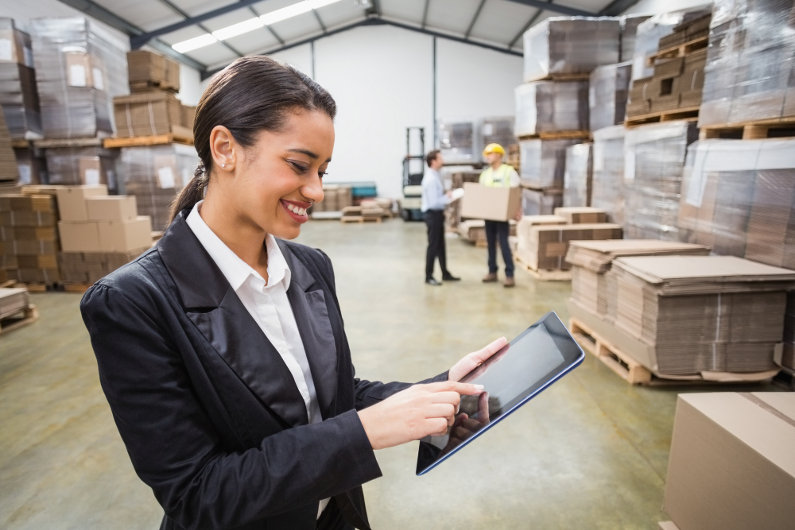Advances in technology have impacted all industries, from how consumers interact with them to how they communicate with stakeholders. But how has technology affected the supply chain of retail brands?
Technology has clearly changed how businesses make supply chains more efficient, but what exactly has changed and how will retail and technology merge further in the future?

The evolving demands of retail consumers
For some retail business owners and managers, demanding consumers are an issue. Many consumers expect convenience from all angles now that they know it’s possible. When they’ve received one service from a business, the bar is raised, and they expect that all their other favourite brands will do the same.
Getting a product to their front door the very next day and being able to check online for its delivery progress is vital for a lot of consumers. For businesses, this means that an efficient supply chain with a well-managed inventory tracking system is essential. And, when it comes to getting in touch with the business, customers expect instant contact through the channels that they’re most used to — Twitter, Facebook and instant messaging platforms.
Kicking off the supply chain in retail
To start, have tech-based advances transformed how businesses are actually making their products? In the Digital Age, more products are being tailored to the buyer due to their love for personalised purchases. For example, you can customise everything from photo frames and jewellery to men’s shirts and sports shoes. However, customers still expect fast manufacturing and for their order to be delivered quickly. So, how has technology created more of an efficient supply chain?
First, the developments in cloud storage allow data to be stored wirelessly. Consequently, machines can be automatically uploaded and information backed up. As a result, crashes and lost information are no longer a headache.
Who can ignore the help presented to retail brands by 3D printing services? The process of 3D printing is what people are referring to as a form of ‘additive manufacturing’. This is where there are no wasted raw materials. Through this technique, this type of printing is able to create products with time and material efficiency.
When it comes to manually putting together products, androids are at hand to assist us today. When it comes to tailored products, this means that they can be created on demand, providing an efficient creation and delivery service.
AI and its effect
Artificial intelligence is an extremely helpful tool to have at a retail business owner’s disposal. In fact, according to 2017 findings by McKinsey & Company, taking an AI approach to the supply chain could reduce forecasting errors by up to 50% and overall inventory reductions of between 20% and 50%. This sort of technology can think and learn like humans, reacting to stimuli often without human input, too. In the supply chain, AI is able to assist with packaging, research and development, and inventory management to make processes more efficient.
Chief executive of Platform Thinking Labs, Sangeet Paul Choudary, claims: “Having a direct link between the actual data being gathered and conveying that back up the supply chain means that designers and developers in the business can come back with the right products in much shorter lead times.”
Determining emerging trends and pinpointing evolutions in consumer behaviour are both made simpler using AI. Machines with AI abilities can also gather information on location so that warehouses in certain areas can stock more of a product that’s popular in the area. This goes on to improve delivery times and customer satisfaction.
Monitoring stock and submitting accurate data is another attribute of AI. This process removes the potential error of miscounting inventory or recording inaccurate information, which could then go onto lead to the wrong amount of stock being replenished.
With an 180,000 square-foot distribution centre in Scotland that provides “a strong platform to support future growth”, QUIZ — a leading fashion supplier of going-out dresses — utilises live data and insights on product performance to make “informed and speedy key buying decisions”. QUIZ also implements a test and repeat approach to its supply chain so that it can “introduce new products to stores and websites within weeks of identifying trends and reorder successful products quickly.”

How will technology affect the safety of current human employees’ jobs?
Technology is clearly handy, but does this mean jobs are at risk for hard-working human employees?
Computers seem to have been given crucial roles that were formerly filled by humans in some retail companies. At Amazon, for example, employees who were once in charge of securing multimillion-dollar deals with brands have been replaced with software that can predict exactly what shoppers want and how much should be charged.
Then again, factories and warehouses need human monitoring most of the time. One example of this is John Lewis, which opened two new distribution centres in Milton Keynes in 2016 that created 500 new jobs.
Technology can’t take over a role that needs human input. To elaborate, computers can’t offer compassion or understand clients’ needs in the way that humans can, for example. Plus, people are still required for after-sales services.
How will the world of retail look in the future?
Although there are pros and cons for and against technology, it’d be wise for retail business owners to get clued up. When it comes to AI, any platform that has access to customer insights and data has the ability to connect directly to manufacturers to integrate and better inform the process.
Fast delivery is very important to the consumer of today. As more people want the same amount of choice at a higher speed, this means that warehouses must stock a wide range of sizes, colours and styles at each of their locations — in close enough proximity to anyone who orders. In fact, there are already massive distribution centres, equal to the size of a town, which logistical networks that pick products from the shelves and send them on their way to customers.
Intelligence when it comes to your company’s infrastructure is also key. Why not look to implement autonomous electric vehicles that operate through the night or intelligent algorithms that can predict the most efficient routes for customer delivery? Both will make your supply chain much more efficient and consumer-friendly!
Sources
https://cdn.businessoffashion.com/reports/The_State_of_Fashion_2018_v2.pdf
http://fortune.com/2017/09/01/supply-chain-manufacturing-technology/
https://www.arnoldmachine.com/6-exciting-advances-manufacturing-automation/

